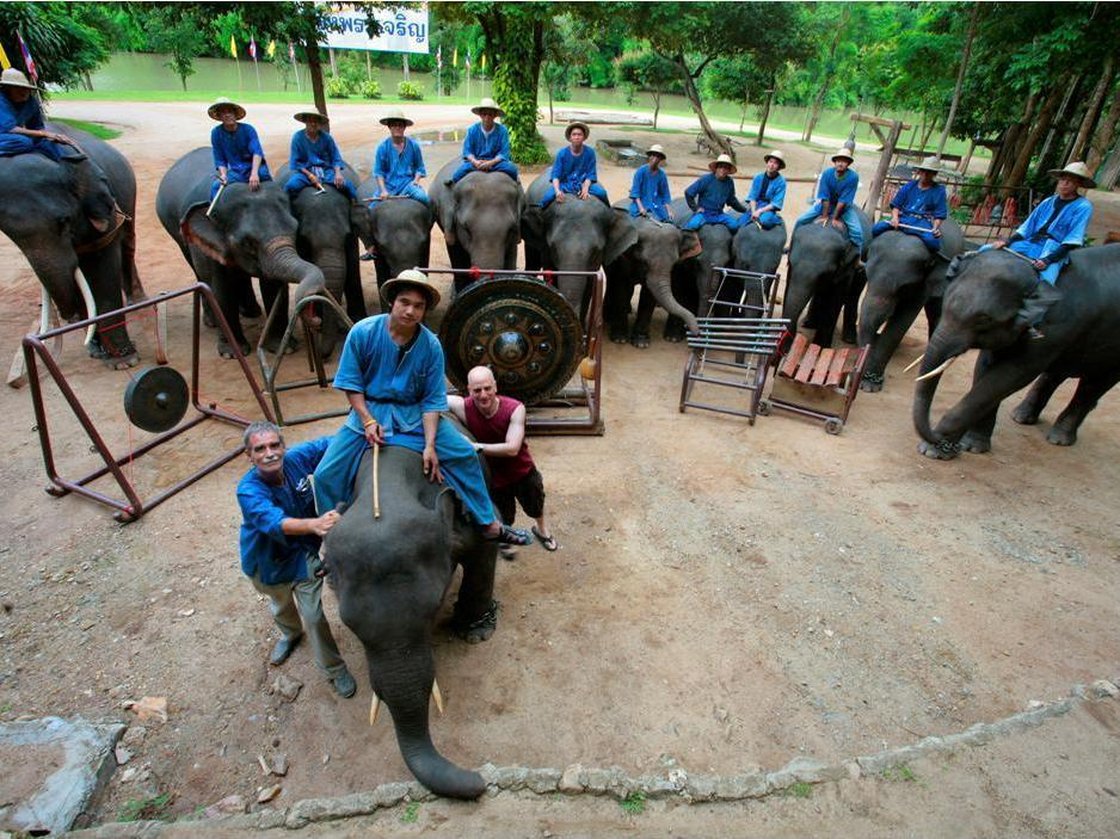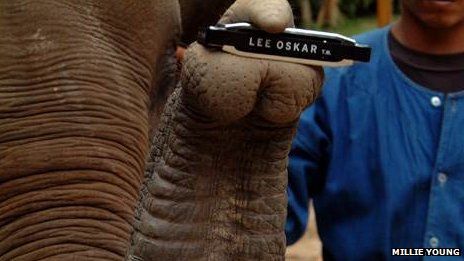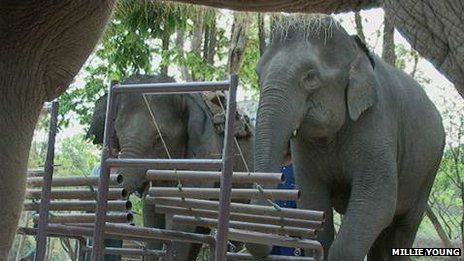
Classical purists might find its percussion section a bit heavy and not all performers pay attention to the conductor. But then this is the orchestra that literally plays for peanuts.
Mei Kot likes to smash the hell out of a gong. Chapati is very, very good at the bass," says Dave Soldier, co-founder of a group that boasts it weighs three times as much as the Berlin Philharmonic.
"Phong would pick up a stick and we couldn't get him to stop.
"Luk Kop could play three drums at the same time. He could even set up rhythms. But he grew to be fairly dangerous, and he's no longer with the orchestra."
The Thai Elephant Orchestra is the creation of Soldier and Richard Lair, an American known as "Professor Elephant" who runs the conservation centre in Lampang, northern Thailand, that is the animals' home.
"We thought that maybe elephants would play on instruments if they were ergonomic," says Soldier, an accomplished musician and composer who has performed and recorded with the likes of Bo Diddley and David Byrne. "We thought about designing large instruments that were unbreakable, as even a little hit would break a regular instrument into smithereens."
Formed in 2000, the orchestra provided Soldier with an opportunity to explore the cognitive and musical abilities of elephants - he is also a professor of neuroscience at Columbia University.
For Lair, instrument-playing elephants provided an attraction that might help raise the funds his conservation centre badly needed.
Not long before, the government had tightened controls on the logging industry, leaving many domesticated elephants out of work - and their mahouts (keepers) struggling to pay for their upkeep.
"Richard invited me to Thailand and I built giant instruments in the metal workshop," says Soldier. The orchestra now has 22 of them, all designed to be operated with the elephant's trunk or with a stick held in the trunk.
Soldier was aware of research by the University of Kansas that showed elephants had the ability to distinguish basic melodies. But he imagined training the animals to actually make music for themselves would be difficult.
"I thought that we'd have to give them a banana every time they hit it and an apple every time they made a note," he says. "But it was nothing like that - I would play it, hand them the stick and that was it. They were playing in a few minutes."
"Thai people tell me it sounds like the music in the Buddhist temples."The mahouts had always played and sung music to their elephants, believing it made them calmer and happier. Now they sometimes accompany the elephants by singing or playing string instruments.
All the custom-designed instruments are made to look and sound Thai, but the elephants can also play a standard harmonica.
"Asian elephants can hold a harmonica very easily, as the end of their trunk has finger like abilities," explains Soldier. "One morning I got to the jungle at sunrise and all around me was the sound of a dozen elephants playing the harmonica as they converged on the river for their morning bath. That was really an astonishing experience."
The orchestra has so far recorded three albums of music. Some of the tracks are improvised, the mahouts only signalling to the elephants when to start and when to stop. Other tracks feature traditional Thai melodies, in which each elephant plays a note of the scale at a cue from a mahout.
So are the Thai elephants genuine musicians?
The sounds of certain animals have long been considered musical. Mozart transcribed the melody of his pet starling in a diary. The second movement of Beethoven's Pastoral Symphony includes a passage for three woodwind instruments imitating a nightingale (flute), quail (oboe), and cuckoo (clarinet), and the 20th Century French composer Olivier Messiaen made a habit of incorporating transcribed birdsong into his works.
Meanwhile, whale song has been marketed as music to sit back and enjoy ever since marine scientist Roger Payne released an LP, Songs of the Humpback Whale, in 1970.
But these are reproductions of natural animal sounds, unlike the music of the Thai elephants which Soldier believes are consciously using instruments to improvise new tunes - and doing so because they enjoy it, just as human musicians do.
"The elephants develop and learn to play in different ways," says Soldier, who believes the elephants now enjoy well-tuned instruments. "They learn where the sweet spot on the instrument is, but no-one has taught them how." Soldier conducted a test in which he planted a dissonant note on a ranat, a Thai version of the xylophone, and observed how the elephant then avoided it, preferring those that were in tune.
The orchestra mainly uses the five notes of the Thai "lanna" scale.
Last December Soldier investigated whether the music of the elephants could even be passed off as "genuine" music. A human orchestra in New York performed an arrangement of one of the elephants' own compositions. The audience was then asked to guess who the composer was. To Soldier's delight, suggestions included John Cage, Alan Hovhaness, Dvorak, Milica Paranosic, and Charles Ives.
"When you spend time with elephants you are astonished at the depths of their personalities," he says. "They do things that you just can't imagine other animals doing and they are capable of incredibly complicated behaviour."
Soldier has also conducted tests to see whether other species will play instruments. His conclusion is yes, they will. He designed a system of levers for captive zebra finches which, when pecked, would trigger playback of a sample of music.
The only reward for the bird was the sound of the music. In another experiment, Pygmy chimpanzees in San Diego Zoo were given hand-bells, and gave every sign of enjoying the opportunity to experiment with sound.
Soldier, however, accepts some are sceptical about his theories but he is certain that his experiments do prove something.
"I'm saying let's spark our imagination when we think of our relationships with other animals," he says. "This appreciation for art and music seems to go far, far beyond our species."






Should prolly be under Society's Child. And with more information added.